Parque Natural de Urkiola · Ayuntamiento de Abadiño
Situación
Menú principal
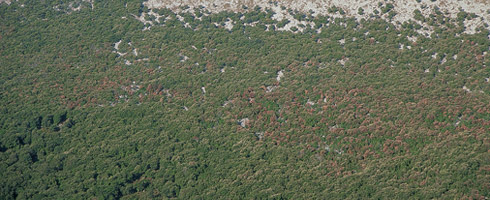
The holm oak is the second native forest in terms of surface area in the Park (6%). Consisting mainly of holm oaks, this type of forest grows well in drought conditions and the holm oak is therefore more typical of regions with a Mediterranean climate than one with a high rainfall, such as Urkiola. There are probably two main reasons why the holm oak is so widespread on the Duranguesado mountains. On the one hand, it seems that after the last ice age, there was a warmer and drier period than the current one when Mediterranean vegetation must have spread along the Ebro valley to the north of the Iberian Peninsula. On the other hand, we should remember that despite the damp climate, the limestone rock zones between 300-800 m high are ideal for the holm oak thanks to the dryness of the land and the lack of competition with other species.
Together with the holm oak, perennial trees and bushes, such as the tree strawberry, the bay tree, glossy buckthorn and jasmine box form a leafy and thick forest. In the past, holm oak was widely used and this led to the tree nearly disappearing in some areas. Nowadays, the majority of the holm oaks in the Park are young and they are mainly to be found in the upper part of the Artaun district in Dima, Axbizkar, Eskuagatx and Mugarra. From the point of view of conservation, the holm oak is a highly important forest, as it is home to a wide variety of flora and fauna.
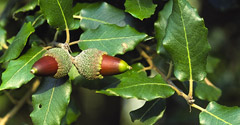
Tree growing up to 20 m high, with a wide and round crown. The trunk is covered with dark grey and very cracked bark. The leaves are ovalate, hard and the tops are dark green and the underside white. It flowers from April to May and the acorns ripen between October and November. It nearly always grows in rocky areas and apart from the aforementioned holm oak forests, they can be found scattered over the slopes of Alluitz and Untzillatx. The acorn is a staple food for many animals.
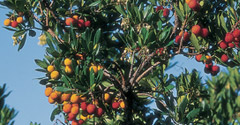
Perennial bush that does not usually grow over 6 m high. The bark is reddish and pulls away in long strips. The leaves are rather hard, slightly long and with a slightly serrated edge. It flowers from September to January and its fruit is a round red or orange berry. It is edible, although it can cause intoxication if eaten to excess. The fruit is also used to make alcoholic drinks and jams.
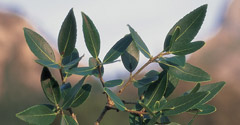
Perennial bush up to 1-5 m high. The bark is grey and smooth. The leaves grow on either side of the branches, they are lanceolate and bright green. The young leaves have a serrated edge. They flower from April to May and produce a small round and meaty fruit at the end of summer. It is found in all the holm oak forests in the Park. The leaves and fruit were used as astringent and to cure mouth ulcers.
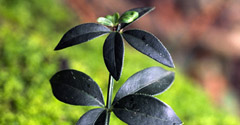
Climbing plant that is 0,.5-2 m in length. The stalk is square and very sticky. The leaves are oval, end in a point and arranged in groups of 4 to 6. It flowers from June to September and the flowers are small and yellowish-green. The fruit is black berries. It is an easy plant to recognise due to its stickiness, which makes it stick to clothes or the skin.
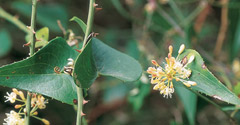
Perennial climbing plant, 1-15 m long, with thorny, angular stems. The leaves are heart-shaped, with sharp lobulates and small thorns. It flowers from August to October and the flowers are yellowish-green. The berry is red or balck. The soft stalks are edible and can be used instead of asparagus and its fruit can be used to prepare a refreshing drink.
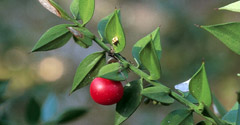
Small bush, 20-80 cm high, with very rigid green stems. It does not have leaves and what looks like leaves are really flat protuberances from the stem, oval-lanceolate in shape and end in a thorn. It flowers from December to May and has small green flowers. The fruit is a very bright red berry. As they are so rigid, the branches of this tree are used to make brooms, which explains its name.
2006 - 2007 © Anteiglesia de Abadiño Town Council - All rights reserved